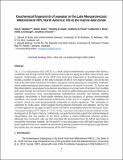Files in this item
Geochemical fingerprints of seawater in the Late Mesoproterozoic Midcontinent Rift, North America : life at the marine-land divide
Item metadata
| dc.contributor.author | Stueeken, Eva E. | |
| dc.contributor.author | Jones, Simon | |
| dc.contributor.author | Raub, Timothy D. | |
| dc.contributor.author | Prave, Tony | |
| dc.contributor.author | Rose, Catherine V. | |
| dc.contributor.author | Linnekogel, Stella | |
| dc.contributor.author | Cloutier, Jonathan | |
| dc.date.accessioned | 2021-08-05T23:40:00Z | |
| dc.date.available | 2021-08-05T23:40:00Z | |
| dc.date.issued | 2020-10-20 | |
| dc.identifier | 269735193 | |
| dc.identifier | 89c3cb05-625b-4f13-add9-3e3faec10860 | |
| dc.identifier | 85089107109 | |
| dc.identifier | 000575085100009 | |
| dc.identifier.citation | Stueeken , E E , Jones , S , Raub , T D , Prave , T , Rose , C V , Linnekogel , S & Cloutier , J 2020 , ' Geochemical fingerprints of seawater in the Late Mesoproterozoic Midcontinent Rift, North America : life at the marine-land divide ' , Chemical Geology , vol. 553 , 119812 . https://doi.org/10.1016/j.chemgeo.2020.119812 | en |
| dc.identifier.issn | 0009-2541 | |
| dc.identifier.other | ORCID: /0000-0002-4614-3774/work/79226710 | |
| dc.identifier.other | ORCID: /0000-0002-9432-9880/work/79226895 | |
| dc.identifier.other | ORCID: /0000-0001-6861-2490/work/79226930 | |
| dc.identifier.other | ORCID: /0000-0001-8149-0977/work/79226942 | |
| dc.identifier.other | ORCID: /0000-0003-4513-2245/work/84315180 | |
| dc.identifier.uri | https://hdl.handle.net/10023/23727 | |
| dc.description.abstract | The 1.1 Ga Midcontinent Rift (MCR) is a thick volcanic-sedimentary succession that forms a curvilinear belt through central North America and crops out along its northern apex around Lake Superior. Sedimentary units of the MCR have been long interpreted as fluvial-lacustrine and invited a number of studies on the early evolution of life in non-marine habitats. One of the key units is the siliciclastic Nonesuch Formation, thought to record deposition in a large lake. However, recent sedimentological observations indicate the presence of marine incursions. To further test this interpretation, we analysed trace element abundances in a broad suite of samples from multiple drill cores through the Nonesuch Formation. We aimed to differentiate geochemical influences of sediment provenance from post-depositional hydrothermal overprint and thereby identify authigenic enrichments in fluid-mobile elements that are indicators of primary environmental conditions. Our results reveal discrete enrichments in Mo and U in organic- and sulphide-rich horizons, which are most parsimoniously interpreted as marine signatures. This conclusion is supported by Sr/Ba ratios, which suggest mixing between freshwater and saltwater, and by rare cm-thick gypsum in the upper Copper Harbor Formation immediately below the Nonesuch rocks. The gypsum displays δ34S values of +25.9 ± 0.6‰, consistent with input of marine sulphate at least during parts of the basin's history. Collectively, our geochemical data support the sedimentological interpretation that this portion of the MCR archives a marine-influenced estuarine system. Although this conclusion rules out that microbial life documented from the MCR was living in exclusively freshwater habitats, the Nonesuch Fm and associated rocks still hold important clues about organisms that were capable of withstanding salinity gradients and bridging the gap between the marine and non-marine environments of the mid-Proterozoic. | |
| dc.format.extent | 888206 | |
| dc.language.iso | eng | |
| dc.relation.ispartof | Chemical Geology | en |
| dc.subject | GE Environmental Sciences | en |
| dc.subject | DAS | en |
| dc.subject | SDG 14 - Life Below Water | en |
| dc.subject.lcc | GE | en |
| dc.title | Geochemical fingerprints of seawater in the Late Mesoproterozoic Midcontinent Rift, North America : life at the marine-land divide | en |
| dc.type | Journal article | en |
| dc.contributor.institution | University of St Andrews. School of Earth & Environmental Sciences | en |
| dc.contributor.institution | University of St Andrews. St Andrews Centre for Exoplanet Science | en |
| dc.contributor.institution | University of St Andrews. Marine Alliance for Science & Technology Scotland | en |
| dc.contributor.institution | University of St Andrews. Scottish Oceans Institute | en |
| dc.contributor.institution | University of St Andrews. St Andrews Sustainability Institute | en |
| dc.contributor.institution | University of St Andrews. St Andrews Isotope Geochemistry | en |
| dc.identifier.doi | https://doi.org/10.1016/j.chemgeo.2020.119812 | |
| dc.description.status | Peer reviewed | en |
| dc.date.embargoedUntil | 2021-08-06 |
This item appears in the following Collection(s)
Items in the St Andrews Research Repository are protected by copyright, with all rights reserved, unless otherwise indicated.

